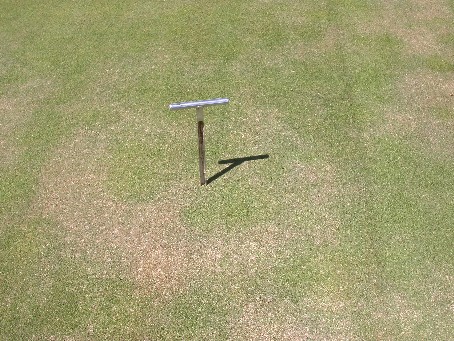For those of you managing sand-based putting greens you may have noticed some turf areas that don’t seem to be vigorously growing even with the recent heavy rainfalls or regular irrigation (photo). Looking back, April and the early part of May was a challenging time for turf managers trying to manage water on the golf course. For most of the state April was one of the 10 driest on record and even if you had an automatic irrigation system, the ever present winds certainly reduced irrigation efficiency. All in all these are wonderful conditions for the development of localized dry spot (LDS) in sand systems. When in doubt the soil probe is still the turf manager’s best diagnostic tool.
That having been said, it may be worth considering an application of a wetting agent to help move water into these hard to wet areas and perhaps more evenly distributing soil moisture. Now, which products should you use? From my research experience I tend to favor a liquid non-ionic soil surfactant (there are many commercially available products and formulations, granular products can work well too, however, I like the idea of having the ability to accurately control my application rates with a sprayer). The important factors to consider are label rates and application frequency. Products that are marketed for season-long control with one application at a high label rates (8-16 oz or higher/ 1000 ft2) generally will cause slight to moderate turf discoloration, the last thing you need going into summer. At this point in the late-spring it may be more prudent to consider a product that is applied at lower rates 3-6 oz/1000 ft2, and repeated on a 14-21 day interval as needed throughout the growing season. (Note: it will probably take two or three applications to correct a situation like the one observed in the photo). Other factors to consider are: make sure you irrigate the application area immediately after applying the wetting agent. This will maximize product efficacy and minimize any potential for turf damage. Lastly, an early morning application when the turf is well hydrated and most healthy will also minimize any chance for discoloration. Do not tank mix these products with high salt index fertilizers like ammonium sulfate or turf burn will certainly occur. Good luck!
 |